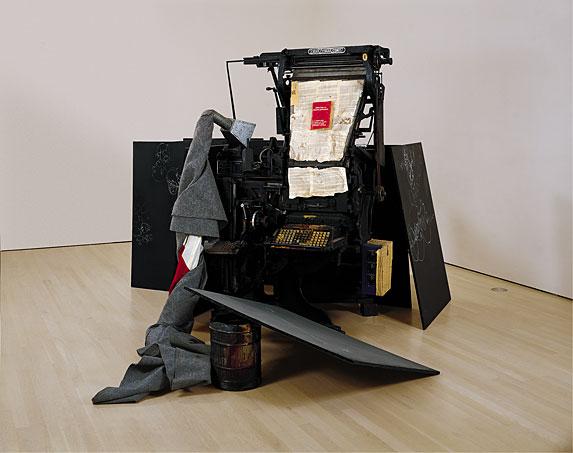Joseph Beuys Gallery
Typesetting machine, Italian flag, felt, nine blackboards with chalk drawings and diagrams, metal container with fat and lead type, cassette recorder with tape, and brochure, 80 x 137 3/4 x 193 inches. Solomon R. Guggenheim Museum.
Terremoto means earthquake in Italian; more specifically, on November 23, 1980, it meant the destruction of a small city on the volcanic heights above Naples. At the invitation of a Neapolitan cultural center, Beuys and several other artists made works to commemorate the lost lives and other effects of the disaster. The Guggenheim Museum’s Terremoto, constructed in Rome at roughly the same time, is a pendant to the Neapolitan work. Although its title and date tie it specifically to the Neapolitan earthquake, it also refers to a contemporary political situation.
This installation reiterates Beuys’s public support of independence for this region of Italy. An Italian flag, wrapped in felt, is draped against an ancient typesetting machine that was once used in the production of the newsletter of a leftist political party, Lotta Continua (The fight continues). Grease has been smeared on the keys of the machine, rendering them dysfunctional. A blackboard on the floor leans against a small oil drum, as if elemental lessons would suffice to educate people to the inequities of capitalism. More blackboards form an altar around the printing machine. They bear alchemical symbols and chalk drawings of skulls, which might represent the victims of the quake.
The manifestos glued to the printing machine refer to the Action Third Way, a theory of political activism that Beuys helped to develop in the late 1970s; it argues for an economic system based neither on the values of Western capitalism nor on the monopolies of the state created by 20th-century interpretations of Marxism. One important element of the Third Way is an emphasis on ecology. Beuys alludes to this in Terremoto by opposing technology with organic substances, and printed texts with handwritten ones. He developed this further in the larger environmental installations dating from the last years of his career, which are among his most far-reaching works, enormous in scope, magnificent in their intention, and involving hundreds of participants. They center around a single theme: his call for a change in thinking that develops out of personal understanding rather than from technological advances.

viewer |
|
|
| Felt Suit |
| Defense of Nature, |
| Animal Woman |
| Encounter with Beuys |
Terremoto |
| Virgin |
| Virgin1979 |
Biography
Bulletin Board
Renowned Art
(home)
Joseph Beuys was in Krefeld but grew up mainly in two nearby towns, Kleve and Rindern. Beuys became associated with the Fluxus movement, eventually becoming its most significant and famous member. He moved from drawing toward performance art motivated by his belief that art has a larger role to play in society. In 1979 Beuys became a founding member of the German Green Party.
all artists, with thumbnails: by birth year | alphabetically
all artists: by birth year | alphabetically
artists born in the 13th 14th 15th 16th 17th 18th 19th 20th century